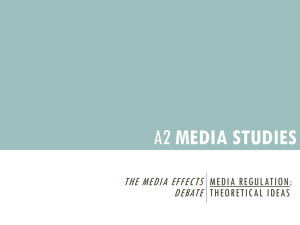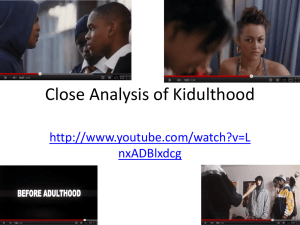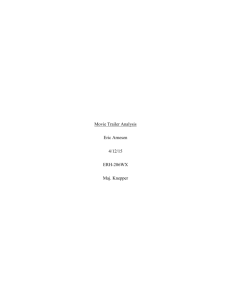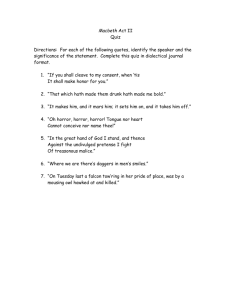task: apply to your trailer
advertisement
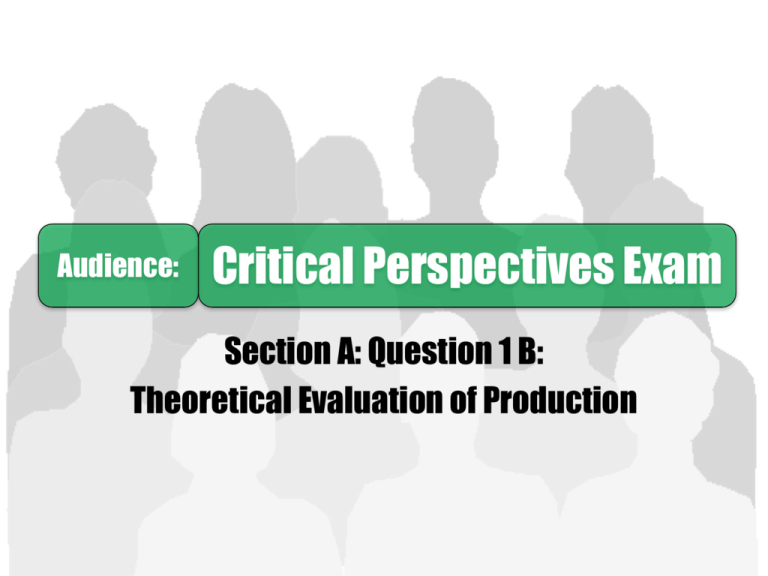
Audience: Critical Perspectives Exam Section A: Question 1 B: Theoretical Evaluation of Production Film: Media Concepts Question 1(B) requires candidates to select ONE PRODUCTION & evaluate it in relation to a media concept. You will focus on your TRAILER ONLY. The list of concepts to which questions will relate is as follows: • Genre • Narrative • Representation • Audience * • Media Language In the exam, questions will be set using one of these concepts. TASK: ANSWER FIVE QUESTIONS • What was your project? • Who was your target audience? • What is horror? • Why do audiences consume horror films? • What was the meaning of your trailer? Audience • How Media affects audiences has been one of the biggest debates in Media Studies. Every opinion & debated issue can be discussed as an audience theory. We can’t prove these theories, but decide on a viewpoint & back up what we believe through research. • There are two viewpoints you must discuss: • Mass Audience Theory (Passive) The media are dangerous as they could influence a lot of people to do dangerous things. Mass audience theorists talk as if everyone reacts the same way to texts. People are often experiencing the media alone- no-one is there to contextualise what they are seeing. • Active Audience Theory The idea that we, as individuals, can interpret media texts in different ways. Media texts are polysemic (meaning - open to interpretations). These theories try to look at the reasons why audience members might respond differently to media texts. AUDIENCE QUOTES – Include one/two in your answer • “Audiences interpret texts very differently. The ‘Dominant Reading’ where they accept the preferred reading, the ‘Negotiated Reading’ where they question the reading, and the ‘Oppositional Reading’ where they reject it” – Stuart Hall. • “In the online age, it is getting harder to conceive a media audience as a stable, identifiable group or temporary collective” – Julian McDougall. • “Institutions are obliged to not only speak about an audience, but crucially talk to one as well. They need not only to represent audiences, but to enter into a relation with them” – John Hartley. • “Moral panic is a mass response to a group, a person or an attitude that becomes defined as a threat to society. New media often create and/or enforce moral panic in the public” – Stanley Cohen. THE EFFECTS MODEL/HYPODERMIC • • • • • THE EFFECTS MODEL The consumption of media texts has an effect or influence upon the audience It is normally considered that this effect is negative Audiences are passive and powerless to prevent the influence The power lies with the message of the text • • • THE HYPODERMIC MODEL Here, the messages in texts are injected into the audience by powerful, syringe-like, media The audience is powerless to resist, therefore, the media works like a drug and the audience is drugged, addicted, doped or duped. • The Effects Model is still the dominant theory used by politicians, some parts of the media and some religious organisations in attributing violence to the consumption of media texts. Key examples sited as causing or being contributory factors are: 1.The film Child’s Play 3 in the murder of James Bulger in 1993 2.The game Manhunt in the murder of Stefan Pakeerah in 2004 by his friend Warren LeBlanc 3.The film A Clockwork Orange (1971) in a number of rapes and violent attacks 4.The film Severance (2006) in the murder of Simon Everitt TASK: APPLY TO YOUR TRAILER • What is wrong with the hypodermic syringe theory? • Can you apply it to your trailer? RESEARCH ACTIVITY: TASK: Research the following ACTIVE theories relating to the Media Effects Debate – Feedback. • Reception Theory • Cultivation Theory • Uses & Gratification Theory • Copycat Theory • Desensitisation Theory • Catharsis • Suspension of Disbelief Reception Theory In the 80’s, Stuart Hall developed an active theory titled ‘encoding & decoding model’, that analysed the relationship between producer & audience. • • The text is coded by the producer and decoded by the audience. Stuart Hall identified three types of audience readings (or decoding) of the text: 1. Dominant or preferred Where the audience decodes the message as the producer wants them to do and broadly agrees with it E.g. Watching a political speech and agreeing with it 2. Negotiated Where the audience accepts, rejects or refines elements of the text in light of previously held views E.g. Neither agreeing or disagreeing with the political speech or being disinterested 3. Oppositional Where the dominant meaning is recognised but rejected for cultural, political or ideological reasons E.g. Total rejection of the political speech and active opposition. Message Audience Decodes Dominant or preferred Producer Encodes Meaning 1. APPLY THIS THEORY TO HORROR 2. APPLY THIS THEORY TO YOUR TRAILER Negotiated Oppositional Cultivation Theory Definition: The theory focuses more on how the media affects peoples attitudes rather than actions. Over exposure to films/television shows can blur an audiences sense of reality the real world: George Gerbner The theory, developed by George Gerbner, claims that “Persistent long term exposure to television content has minimal but measurable effects on the perceptual worlds of audience members”. By comparing the attitudes of heavy, moderate, and light media users, Gerbner found that heavy media users had an attitudinal misconception called mean world syndrome. Overestimating how much violence actually occurs in their communities and the rest of the world, especially when compared to less media users ‘realistic’ world. The more exposure to TV over time, TV will eventually "cultivate" viewers perception of reality. The theory assumes that the audience is passive in nature, therefore the media has a big influence on their ideas and life choices and that eventually our views of the world will come to resemble that of The medias. People's choices and values will mainstream. TASK: APPLY IT! • What would be some key points to make in terms of the horror genre? • Can you apply it to your trailer? Cultivation Theory Uses & Gratification Theory With expanding new forms of media, a study by Blulmer & Katz (1974) stated that audience consumption was based on highly active audience choices & personal preferences. Individuals have different uses for texts, & instead of mindless entertainment, we all expect to get something from it (gratification). Definition: “Uses and Gratification model/theory suggests that people use the media and its many texts, to their advantage and in order to meet their individual needs. – Denis McQuail (1972) Cognitive Needs (Surveillance): People access the media (newspaper, magazines, TV, internet, etc.) to acquire specific information. They want to gain more knowledge, on a certain event or topic. Opposite of the Effects Model as the audience is active The audience uses the text & is NOT used by it. Affective needs (Personal Identity): People use the media to satisfy their emotional needs. In most cases, television is the best form of media to please affective needs. We find ourselves relating to the people on TV. We sympathize when something bad happens to them or we celebrate their victories with them. The audience uses the text for its own gratification/pleasure Personal Integrative Needs (Relationships): Media such adverts on TV fulfil our self esteem. People will change their lifestyle to be cool as according to the media and advertising help them do this. Here, power lies with the audience NOT the producers Social Integrative Needs (Relationships): Social networking sites such as Facebook and Twitter satisfy social integrative needs. These sites let you know what their peers are up too, relationship statuses etc. Tension Free Needs (Diversions/Escapism): People may use tension free needs as an outlet. The media can help a person escape and relieve tension. A person can relax while consuming their favourite song/show/film etc. This theory emphasises how and why audiences use a text. Audience is free to reject, use or play with media as they see fit. TASK: APPLY IT! • What would be some key points to make in terms of the horror genre? • Can you apply it to your trailer? Uses & Gratification Theory Desensitisation THEORIST: Psychologist ‘Mary Cover Jones’ Definition: The desensitisation theory believes that the more violence viewers are exposed to in the media over a period of time, the less sensitive we become to it. The violence no longer seems to bother them or bothers them less than it did before. The theory continues on from the copycat theory, it is a behavioural state and people may experience desensitisation after being exposed to so much violence in the media, it may not have a strong emotional impact on them anymore in the media world. The issue is that this desensitisation may occur when something violent happens in real life, the viewer can become immune to the general shock of these action, making them too comfortable and possible able to perform these acts as they are no longer affect emotional by them anymore. 1973 – The Exorcist 1974 – Texas Chainsaw Massacre 2010 & 2011 – Human Centipede 1 & 2 Banned films that are now available due to social change, this is known as ‘RATINGS CREEP’. TASK: APPLY IT! • What would be some key points to make in terms of the horror genre? • Can you apply it to your trailer? Desensitisation Copycat Theory Definition: Audiences will copy what they see in a media text. It refers to the how the media can influence and affect the audiences behaviour and how they think. Strengths: The influence of this theory is how it psychologically prays off the fears and concerns of parents as well as many independent commissions and engages their parents to more actively monitor the Media that they use. This not only covers movies, but also video games, especially with underage gaming on the rise, with games such as GTA & COD being predominantly played by young people. Weaknesses: The main weakness is the opinion of the people regulating their children, as the preconception of danger varies from person to person, so one person's horror movie is another's comedy. Additionally, while short term effects of the media are easily monitored, the long term are not so easily monitored, and therefore the theory cannot be proven correct. Examples: The most notable example as discussed earlier is the Jamie Bulger murder case (Blamed on Child Play 3). Additionally there are multiple cases of children with short tempers due to constant exposure To competitive and mature gaming and films. TASK: APPLY IT! • What would be some key points to make in terms of the horror genre? • Can you apply it to your trailer? Copycat Theory Catharsis Theory Definition: Catharsis is an emotional effect experienced by people who use the media to purge or cleanse negative emotions, such as fear or anger. Is Viewing Violence Cathartic? The large amount of violence in the mass media is often justified by the concept of catharsis. The word catharsis comes from the Greek word ‘Katharsis’, which literally translated means ”a cleansing or purging." The first recorded mention of catharsis occurred more than one thousand years ago, in the work Poetics by Aristotle. Aristotle: Aristotle taught that viewing tragic plays gave people emotional release (Katharsis) from negative feelings such as pity, fear, and anger. By watching the characters in the play experience tragic events, the negative feelings of the viewer were presumably purged and cleansed. This emotional cleansing was believed to be beneficial to both the individual and society. _________________________________________________________________________________________________________ • As a result, watching aggressive media output, it is proposed, does not make viewers more aggressive; quite the contrary – since the vicarious aggression experienced through the media purges the viewer of aggression, the result of watching violence is less aggression. • Catharsis (meaning purification) theory, implies that the execution of an aggressive action under certain conditions diminishes the aggressive drive and therefore reduces the likelihood of further aggressive actions. • The crucial point in catharsis theory is that the observed aggressive action does not necessarily need to be executed in reality. It can instead take place in the actor's fantasy or in the media (symbolic catharsis). TASK: APPLY IT! • What would be some key points to make in terms of the horror genre? • Can you apply it to your trailer? Catharsis Theory Suspension of Disbelief • In the world of fiction you are often required to believe a premise you would never accept in the real world (story /events which you would not believe even if in the news). • In order to enjoy such stories, the audience engages in a phenomenon known as "suspension of disbelief". A semi-conscious decision in which you put aside your disbelief & accept the premise as ‘real’. • The initial premise can be quite outrageous as long as the story maintains consistency within that premise. – Star Trek universe = impossible in the real world, but the films work consistently within their own universe, so the story is believable. • Genre determines believability. An action hero can perform super-human feats, but not in a Rom-com (audience confusion/disbelief) • Some stories purposely push suspension of disbelief to the limit. – The Indiana Jones movies are a good example, where the audience expects to find the improbable antics amusing. • With human actions/emotions, people must act & interact in believable ways. If interactions do require SOD, the normal rules of consistency apply. Audiences are unforgiving if text is unbelievable. TASK: APPLY IT! • What would be some key points to make in terms of the horror genre? • Can you apply it to your trailer? Suspension of Disbelief Relate Audience Theory to your Product Now you have looked at Audience Theory, consider how you might apply it to your own work. Using your Teaser trailer & an existing real media product (that you have based your product on) ask yourself the following questions: 1.Who is your Target Audience? 2.Why might they choose to watch your product? (i.e. what elements of your teaser trailer would appeal to them?) reflect on Blulmer & Katz’s Gratification model. 3.Are your audience active or passive viewers? (why do you think that?) 4.As producer what codes constructed (and how – technical elements) for the audience to decode? SPARE ACTIVE • • • • 1. The Interpretive Model 2. Structured Interpretation Model Gives some examples of how the active audience can react to a text. Tries to explain why active audiences react differently. We can: ignore the message; react positively to the message; reinterpret the message; forget the message. 3. The Two Step flow Accepts the Media do not exist in a vacuum & other factors alter behaviour. We can modify our behaviour as a mixed result of text & conversation. • • Audience Step One- we first watch a media text. Step Two- we talk about it with others. • • • • • age; gender; social class; race; education + aspirations 4. Two Step Theory Paul Lazarsfeld (1940) suggested media did not flow directly into the audience’s mind unmediated but could be filtered and interpreted depending on social factors, background, experiences etc. Formula: Audience consume information direct from media – audience mediate ideas and thoughts expressed by opinion leaders – are therefore influenced not by a direct process, but by a two step flow. AUDIENCE – FINALISE AN ANSWER PARAGRAPH 1: INTRODUCTION What was your project? - Who was your target audience? - What is horror? – Why do audiences consume horror films? - What was the meaning of your trailer? PARAGRAPH 2: AUDIENCE TYPES Discuss the different types of audience theory (active and passive) – Bring in the Hypodermic Needle/Syringe theory • • • • PARAGRAPH 3: DESENSITISATION PARAGRAPH 4: USES & GRATIFICATION What is the theory? Who is the theorist? Apply it to the content of your trailer? Back it up with an existing film text. • • • • What is the theory? Who is the theorist? Apply one option to your trailer? Back it up with an existing film text. PARAGRAPH 5: CONCLUSION Audience Expectations – The future?
